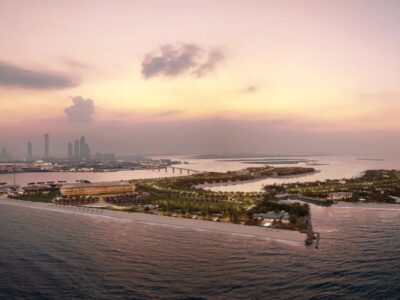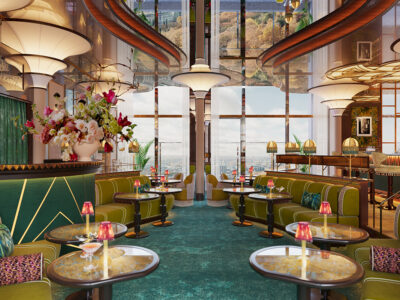Japanese traditions flirt with Arabian accents in Dubai’s very own Nobu restaurant.
The LA-based Nobu Matsuhisa Group of Japanese restaurants, co-owned by Robert de Niro, made its Dubai debut in an 11,500ft2 eatery within the much-publicised Atlantis Hotel.
The task of converting the cavernous space into a setting worthy of one of the world’s biggest names in Japanese dining fell to the New York-headquartered Rockwell Group.
“To begin with, this restaurant was an extremely large white box, probably the largest one level space we have worked with for a Nobu restaurant. The challenge was transforming this space into a series of experiences and environments that create a coherent whole, and also capture the energy of Nobu and Dubai,” said David Rockwell, founder and designer, Rockwell Group.
Nobu Dubai represents an evolution of the design concepts developed for the chain’s other restaurants around the world, with an emphasis on craftsmanship, natural materials and storytelling.
“We have collaborated with Nobu on its restaurants since the opening of the original Nobu restaurant in New York. This design is an evolution of many of the concepts that the firm developed for the flagship Nobu Fifty Seven,” said Rockwell.
“With each additional location, the idea was to continue to use the handcrafted, textural elements reflecting Nobu’s roots in rural Japan, while incorporating elements of the specific context and location.
“So, for Dubai, we wanted to blend the now iconic Nobu features and materials we have used since the beginning, with those that reflect the landscape, history and over-the-top nature of Dubai,” he added.
Aquatic echoes
To inject some local flavour into the Dubai restaurant, the design brief incorporated traditional Arabian elements, as well as echoes of the beachfront.
“This particular restaurant reflects the Dubai beachfront context, with large-scale hand-woven abaca panels made of abaca rope and steel surrounding the restaurant walls and ceiling, evoking an aquatic environment. Accents of traditional Middle Eastern vernacular architecture, such as hand-wrought iron columns of flowers, leaves and buds, are also prominent,” Rockwell detailed.
The woven abaca panels represent a signature element of the restaurant interior.
“Elliptical-shaped translucent panels surround the bar lounge, and are covered with large-scale cherry blossom. These three-dimensional, computer-generated woven abaca panels surround the walls and ceiling of the main dining room, creating an experience akin to being immersed under an ocean wave,” he added.
Moving through the restaurant, a fresh mixture of wood and steel reinforces the natural feel. “For all the selected materials, our goal was to use the crafted, textural, natural materials, and marry them with accents and homages to the Dubai location, making this restaurant truly unique and fresh.”
Fine finishings
The space also incorporates a mixture of three different flooring styles. Floors through the main bar area, sushi bar and restrooms are paved with simple slate, sourced from a local supplier.Meanwhile, black and white terrazzo, embedded with pebbles by Fribel, runs along the floor near the lounge, and wood end grains sourced locally cover the floors of the main dining area.
For the walls, the same nature inspired theme applies. “Custom, laser-cut blackened steel in floral shapes links together to form a lattice screen surrounding the bar, and curved translucent panels with large-scale cherry blossom photography sourced from 3-Form and Michael Palladino line the bar,” Rockwell said.
Finishing touches to a once blank canvas come in the form of ebonised ash table tops and bar stools in the private dining room, and the onyx-topped liquor bar, sushi bar, and host stands.
“We chose furniture with warm and rich materials to complement the textural and tactile aesthetic of Nobu – all of which work perfectly to echo the finely crafted cuisine,” said Rockwell.
“All of the furniture you see in Nobu was especially custom-designed and built. The black walnut bar lounge banquettes surrounded by curved panels form an elliptical-shaped lounge. And the black walnut main dining banquettes were built with organic serpentine-like shapes that followed the same organic curves as the woven abaca panels behind them,” he added.
For Rockwell, the lighting is one of the most significant aspects of the restaurant’s interior, and acts as the ultimate enhancer of the customer experience.
Fish basket lamps hang above the main dining room area and ash veneer shades with incised images of cherry blossoms have been introduced in the private dining room.
“For us, lighting is always one of the most crucial elements of a space. It has the power to transform a space, and set the tone of a restaurant. In our selected light fixtures, you will see that we either used hand-crafted fish baskets, or custom light pendants with incised flowers to reference both the Japanese countryside and the natural and aquatic wonders of Dubai.”
Describing the work of the Rockwell Group as ‘collaborative’, ‘choreographed’, ‘theatrical’ and an ‘immersive environment that fosters connections’, Rockwell believes that Nobu Dubai was the result of ‘cross-disciplinary mish-mosh’ of personalities and talents that all collaborated and brainstormed to come up with innovative ideas.
“It’s all about blurring the boundaries, allowing a plurality of interests to compete, always being alert to the possibility of new juxtapositions, unexpected collisions, to the wealth of inspiration available from cultural landscapes around the globe.
“In all our work there is a focus on creating the environments where guests and visitors want to stay and occupy, to connect, share the moment, and to return. So, I want the spaces I design to make emotional connections with people and provide memorable shared experiences,” Rockwell concluded.
Nobu New York, the flagship restaurant of chef Nobu Matsuhisa, has been a pioneer in Japanese cuisine since its opening in 1994.
Nobu Next Door opened as an extension of the original Nobu restaurant in 1998, while Nobu Fifty Seven was the first uptown New York location for Matsuhisa, and opened in the summer of 2005.
The chain’s first three openings in New York marked the beginning of a creative collaboration between Matsuhisa and the New York-based Rockwell Group.
Matsuhisa went on to open restaurants in other US provinces, before establishing bases worldwide, in Australia, Waikiki, London, Bahamas, Milan, Tokyo, Hong Kong and, most recently, Dubai.






